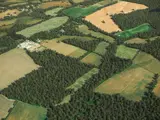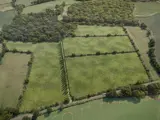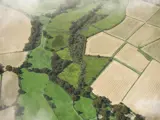Ardingly Habitat Bank, West Sussex
Local planning authority (LPA): Mid Sussex District Council
National Character Area (NCA): High Weald
Biodiversity Units available:
Very high distinctiveness habitats
- Lowland meadows
- Species-rich native hedgerow with trees
High distinctiveness habitats
- Lowland mixed deciduous woodland
Medium distinctiveness habitats
- Mixed scrub
- Other neutral grassland
- Ponds (non-priority habitat)
- Other woodland; broadleaved
Low distinctiveness habitats
- Hedgerow
Located less than ten miles from Crawley, our forty-hectare Ardingly Habitat Bank was secured in 2024. We’ve carefully designed a suitable habitat management plan to boost biodiversity, using strategies to take advantage of the site’s closeness to the Wakehurst and Chiddingly Woods Site of Special Scientific Interest (SSSI).
Here we will transform the existing arable fields into a rich and diverse mosaic of wildflower grassland, mixed scrubland, woodland, and ponds. Meadows will be managed using conservation grazing strategies to benefit the land – reflecting traditional and historic land management techniques.
Following a thorough assessment of the site's vegetation, wildlife, geology, hydrology, soil chemistry, management history, and landscape connectivity, we determined the best possible habitats to establish and made sure these enhancements would be deliverable. We established an ecological baseline for the site using Defra’s biodiversity metric, so we can clearly demonstrate biodiversity gains over time.
This assessment enables us to generate a range of high-integrity Biodiversity Unit habitat types that will ensure robust ecological outcomes. We also offer planning support to make sure our Biodiversity Units provide an effective local BNG delivery solution for developers within the Mid Sussex District Council LPA area or High Weald NCA. Our Units are ready to purchase now, subject to availability.
Adjacent LPAs for cross-boundary coverage:
- Lewes District Council
- Wealden District Council
- Horsham District Council
- Crawley Borough Council
- Tandridge District Council
- South Downs National Park
Adjacent NCAs for cross-boundary coverage:
- Low Weald
- Pevensey Levels
- Romney Marshes
We’ll be connecting habitats across the local landscape, particularly between pockets of ancient woodland to allow wildlife to travel.
By enhancing the landscape and creating new habitats for wildlife, we hope to see a number of species increase in abundance over the coming years. This may include reptiles such as slow worms, amphibians such as great crested newts, invertebrates such as stag beetles and silver-washed fritillary butterflies, and birds such as nightingales.
We’re also planning to enhance the health of the soil by reducing nutrient levels and improving its structure. This will not only help the habitats thrive, but it will also enable the soil to better store and filter water. Enhancements such as these are so vital for helping make the landscape more resilient against the worst effects of climate change.
Find out the cost and availability of Biodiversity Units from our Ardingly Habitat Bank




